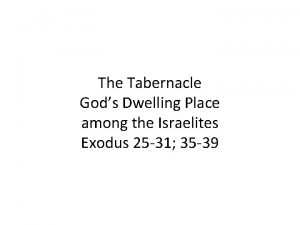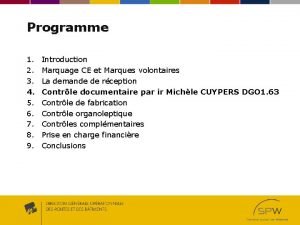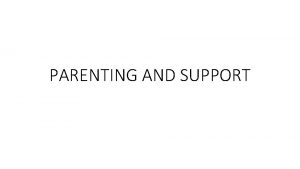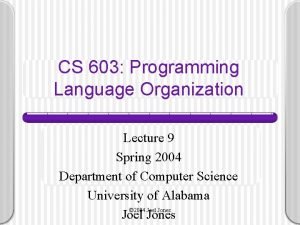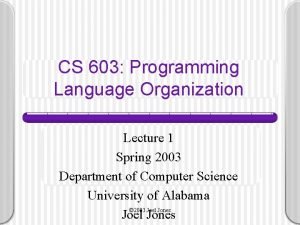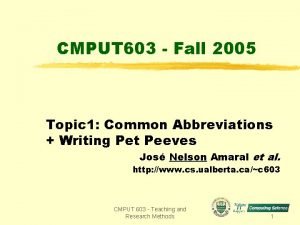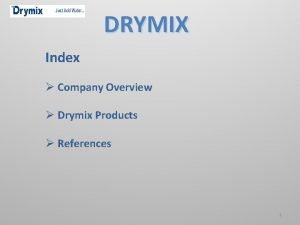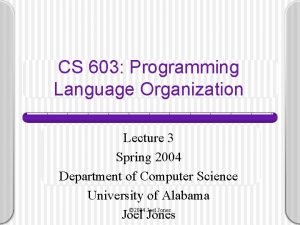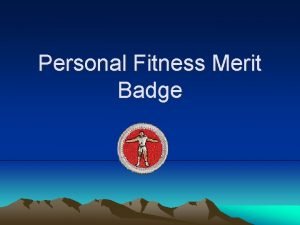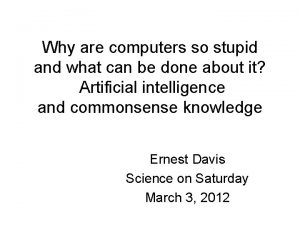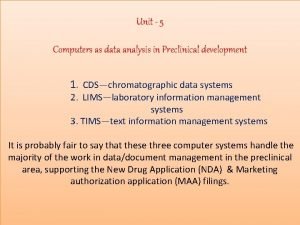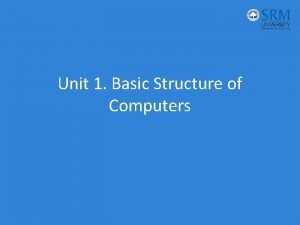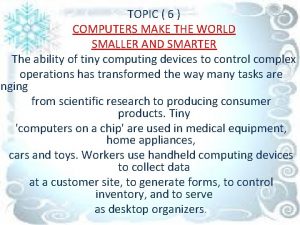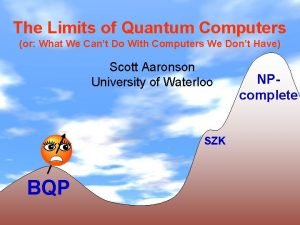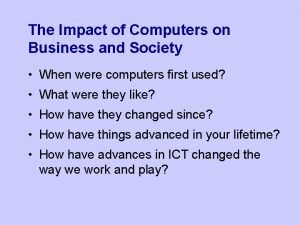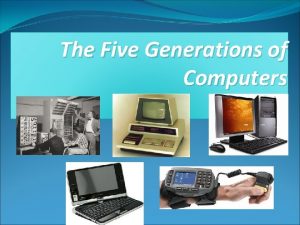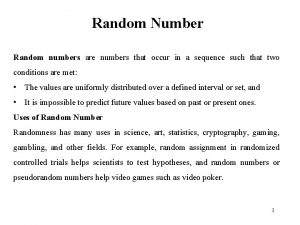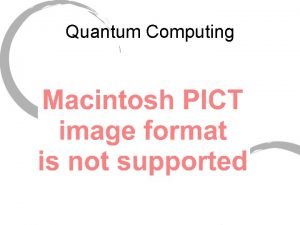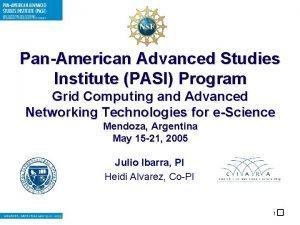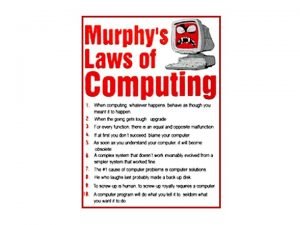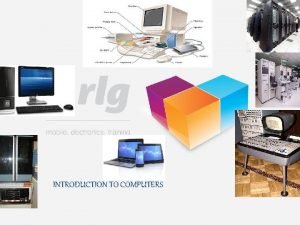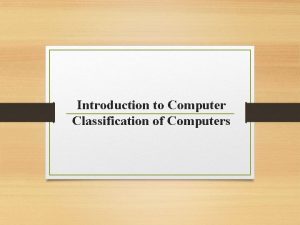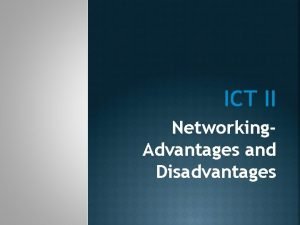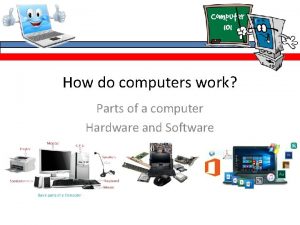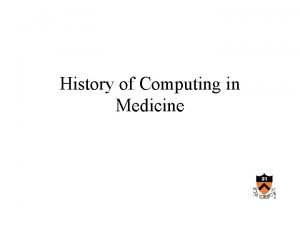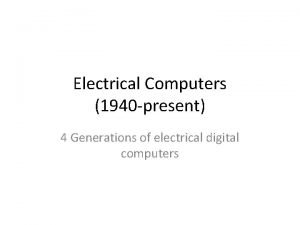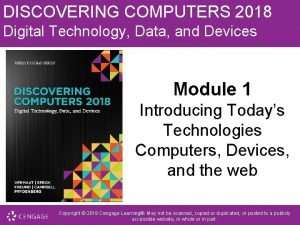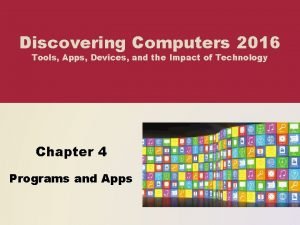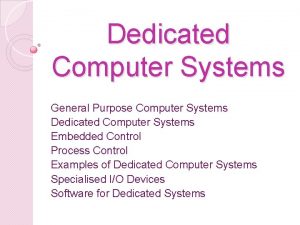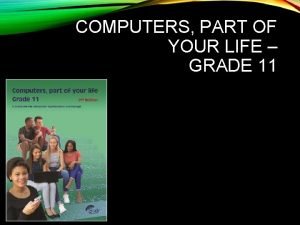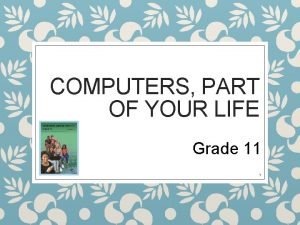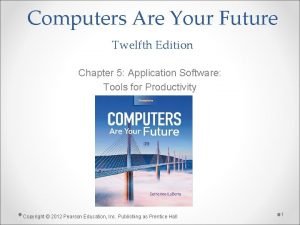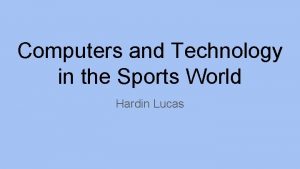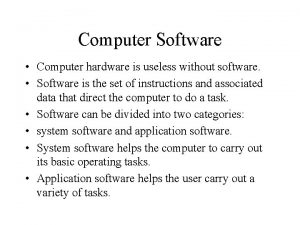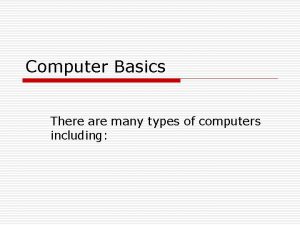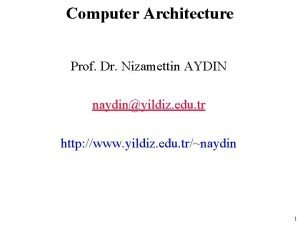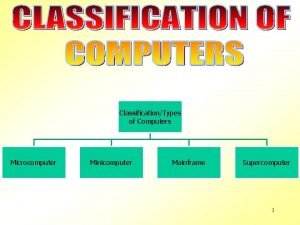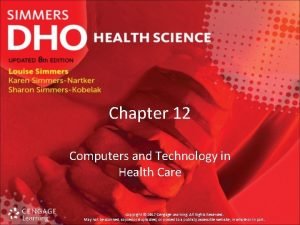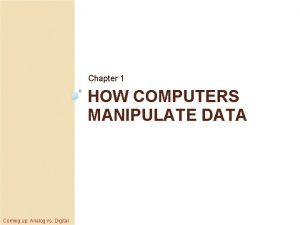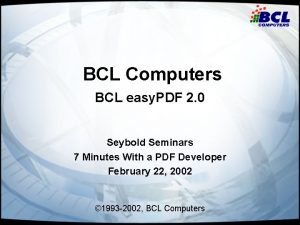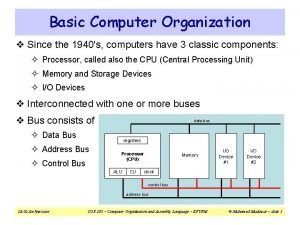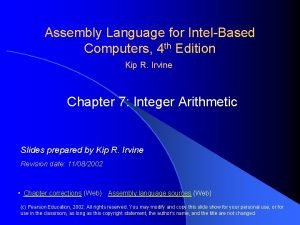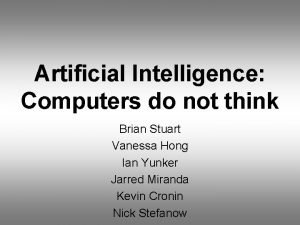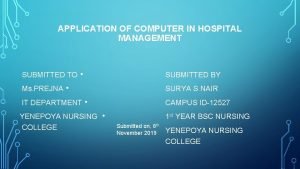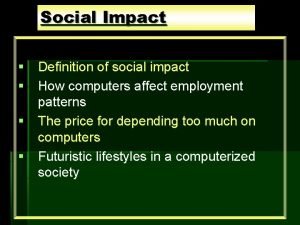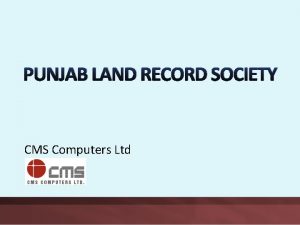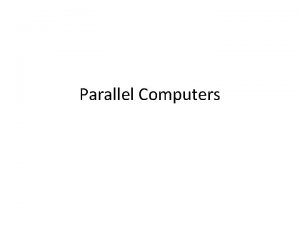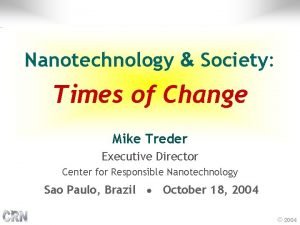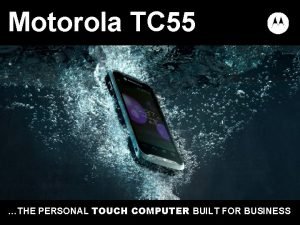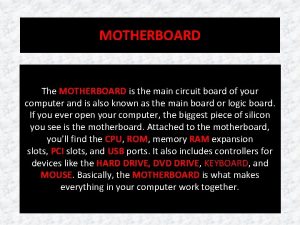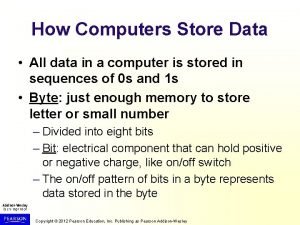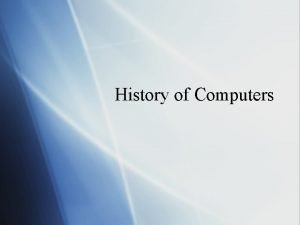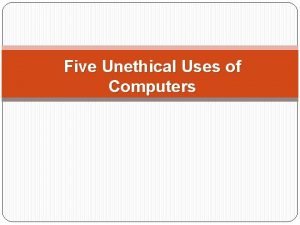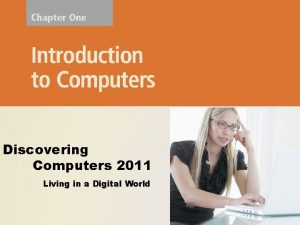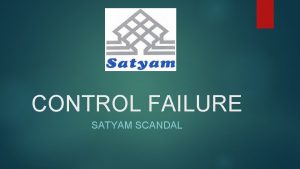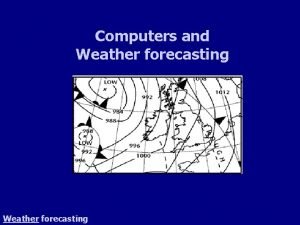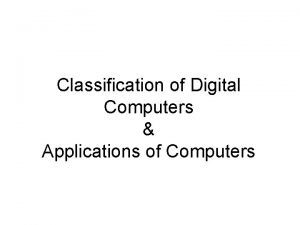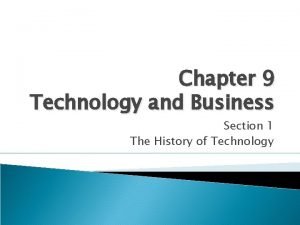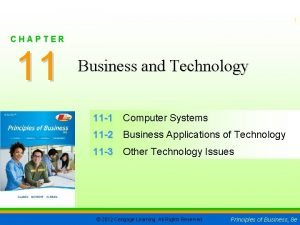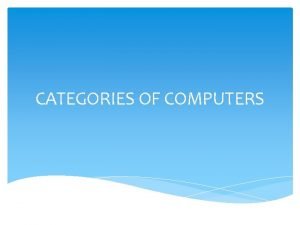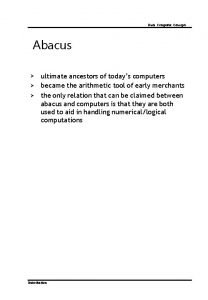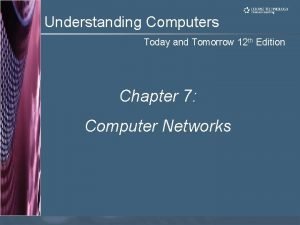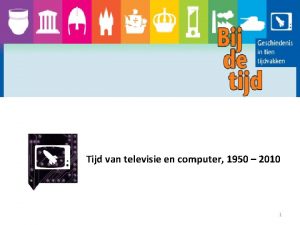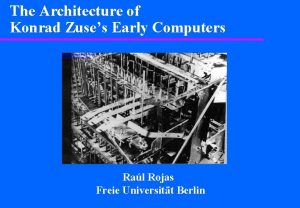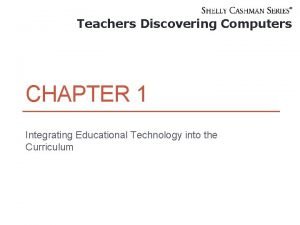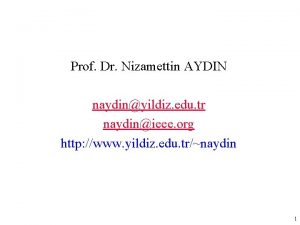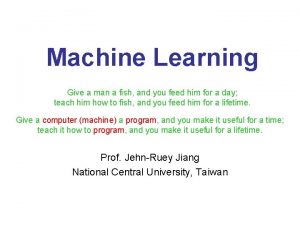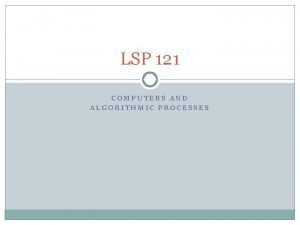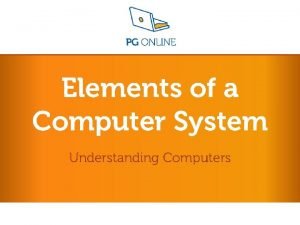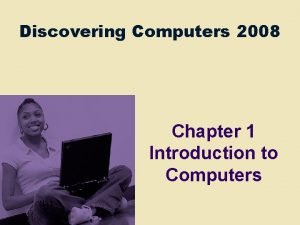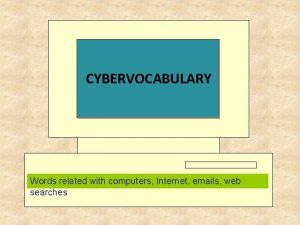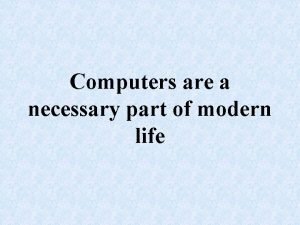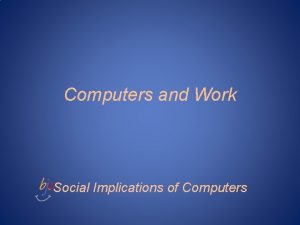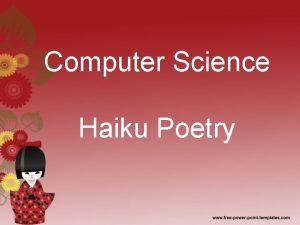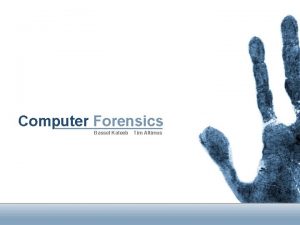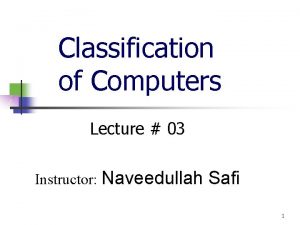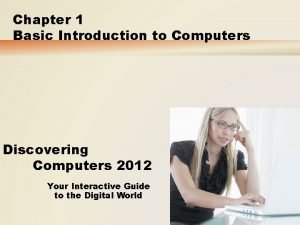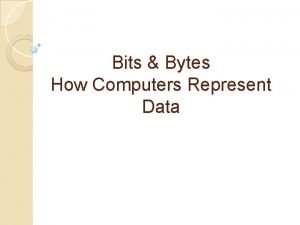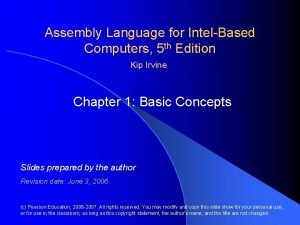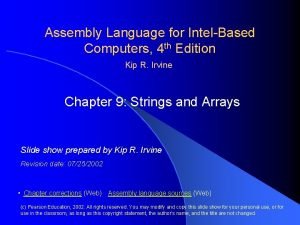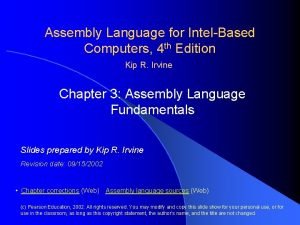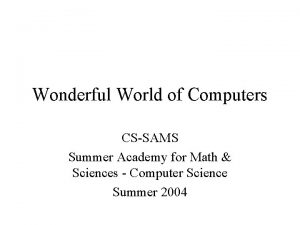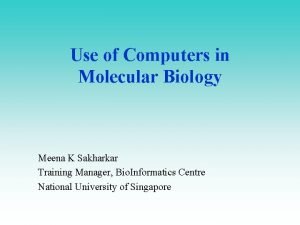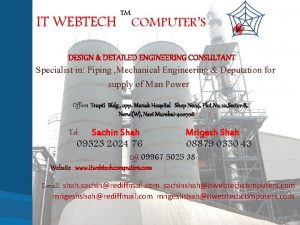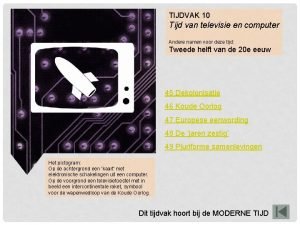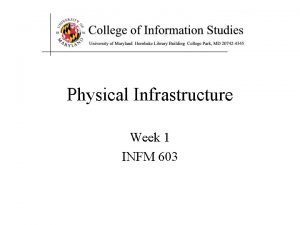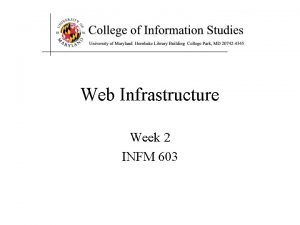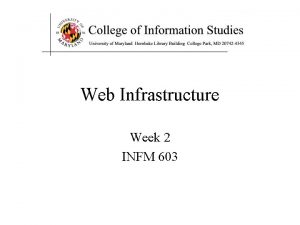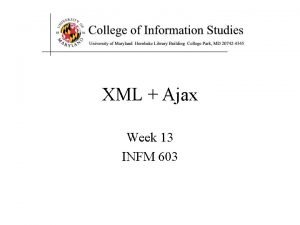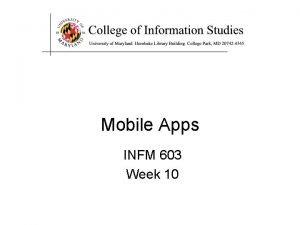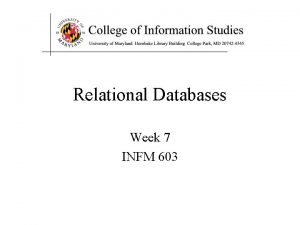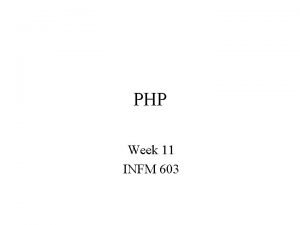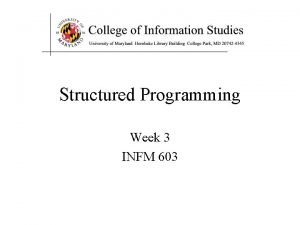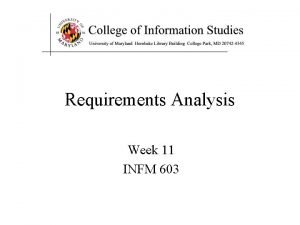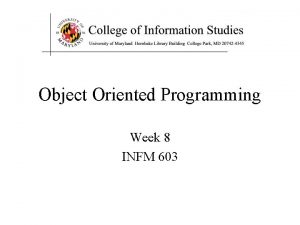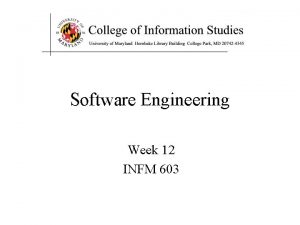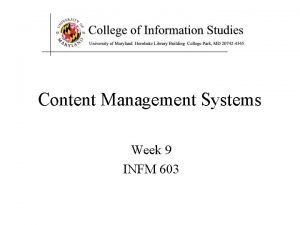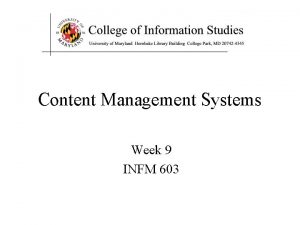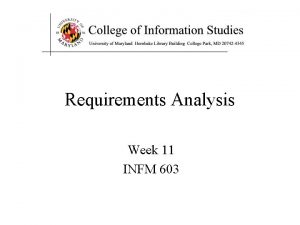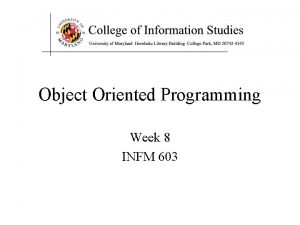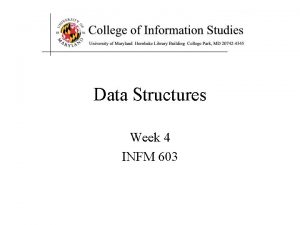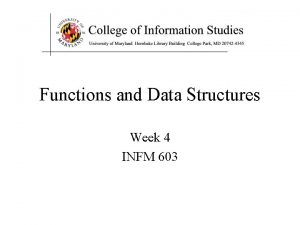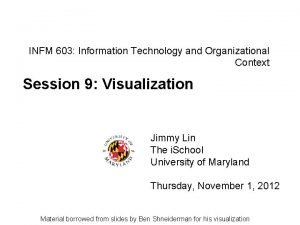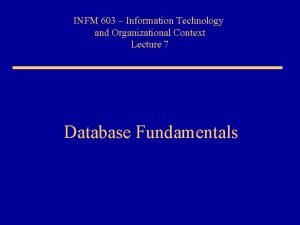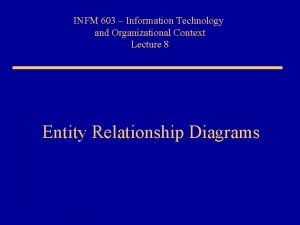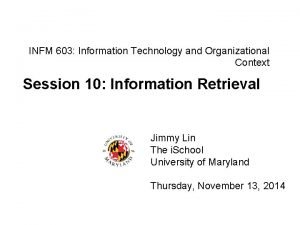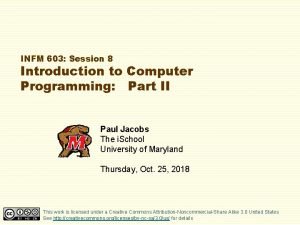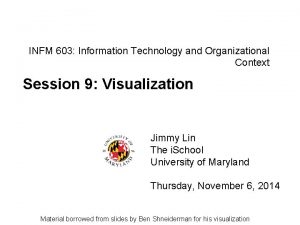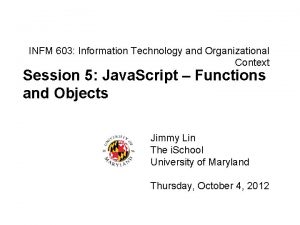Physical Infrastructure Week 1 INFM 603 Agenda Computers





































































































- Slides: 101

Physical Infrastructure Week 1 INFM 603

Agenda • Computers • The Internet • The Web • About the course


A Very Brief History of Computing • Hardware – Mechanical: essentially a big adding machine – Analog: designed for calculus, limited accuracy – Digital: early machines filled a room – Microchips: designed for missile guidance • Software – Numeric: computing gun angles – Symbolic: code-breaking

Source: Wikipedia

Source: Wikipedia

Source: Wikipedia

Source: Wikipedia

Source: Wikipedia

Source: Wikipedia

Input Devices • Text – Keyboard, optical character recognition – Speech recognition, handwriting recognition • Direct manipulation – 2 -D: mouse, trackball, touchpad, touchscreen – 3 -D: wand, data glove • Remote sensing – Camera, speaker ID, head tracker, eye tracker

Input Example: QWERTY Keyboard From http: //home. earthlink. net/~dcrehr/whyqwert. html

Dvorak Keyboard From http: //www. mwbrooks. com/dvorak/

Binary Data Representation Example: American Standard Code for Information Interchange (ASCII) 01000001 01000010 01000011 01000101 01000110 01000111 01001000 01001001010 01001011 01001100 01001101 01001110 01001111 01010000 01010001 … =A =B =C =D =E =F =G =H =I =J =K =L =M =N =O =P =Q 01100001 01100010 01100011 01100100 01100101 01100111 01101000 01101001 01101010 01101011 01101100 01101101110 01101111 01110000 01110001 … =a =b =c =d =e =f =g =h =i =j =k =l =m =n =o =p =q

Output Devices • Visual – Screen, projector, head-mounted display, CAVE • Acoustic – Speakers, headphones • Physical – Tactile (vibrotactile, pneumatic, piezoelectric) – Force feedback (pen, joystick, exoskeleton) – Thermal • Vestibular (motion-based simulators) • Locomotive (treadmill, stationary bicycle) • Olfactory

Extracted From Shelly Cashman Vermatt’s Discovering Computers 2004

The Big Picture Processor Network Memory

Hardware Processing Cycle • Input comes from somewhere – Keyboard, mouse, microphone, camera, … • The system does something with it – Processor, memory, software, network, … • Output goes somewhere – Monitor, speaker, robot controls, …

Computer Hardware • Central Processing Unit (CPU) – Intel Xeon, Motorola Power PC, … • Communications “Bus” – FSB, PCI, ISA, USB, Firewire, … • Storage devices – Cache, RAM, hard drive, floppy disk, … • External communications – Modem, Ethernet, GPRS, 802. 11, …

What’s that?

Units of Frequency Unit hertz kilohertz megahertz Abbreviation Hz KHz MHz Cycles per second 1 103 = 1, 000 106 = 1, 000 gigahertz GHz 109 = 1, 000, 000

Units of Time Unit second millisecond microsecond Abbreviation sec/s ms ms Duration (seconds) 1 10 -3 = 1/1, 000 10 -6 = 1/1, 000 nanosecond picosecond femtosecond ns ps fs 10 -9 = 1/1, 000, 000 10 -12 = 1/1, 000, 000 10 -15 = 1/1, 000, 000

The Storage Hierarchy • Speed, cost, and size: – You can easily get any 2, but not all 3 • Fast memory is expensive – So large memory is slow! – But fast access to large memories is needed • Solution: – Keep what you need often in small (fast) places • Keep the rest in large (slow) places – Get things to the fast place before you need them

Best of Both Worlds Small, but fast… + = Is Large and seems fast Large, but slow… Think about your bookshelf and the library…

Locality • Spatial locality: – If the system fetched x, it is likely to fetch data located near x • Temporal locality: – If the system fetched x, it is likely to fetch x again

System Architecture Keyboard Sound Card Video Card Mouse Input Controller System Bus Front Side Bus L 2 CPU L 1 Cache RAM Motherboard Hard Drive CD/ DVD USB Port

Everything is Relative • The CPU is the fastest part of a computer – 3 GHz Core 2 Duo = 6, 000 MIPS • 3 operations per processor every nanosecond • Cache memory is fast enough to keep up – 128 k. B L 1 cache on chip (dedicated, CPU speed) – 4 MB L 2 cache on chip (shared, CPU speed) • RAM is larger, but slower – 1 GB or more, ~6 ns

Units of Size Unit byte kilobyte Abbreviation b B KB Size (bytes) 1/8 1 210 = 1024 megabyte gigabyte terabyte petabyte MB GB TB PB 220 = 1, 048, 576 230 = 1, 073, 741, 824 240 = 1, 099, 511, 627, 776 250 = 1, 125, 899, 906, 842, 624

The Storage Hierarchy Type Registers Cache RAM Hard drive Speed ~300 ps ~1 ns ~10 ms Size 256 B 4 MB 1 GB 100 GB Cost Very expensive Expensive Cheap Very cheap

“Solid-State” Memory • ROM – Does not require power to retain content – Used for “Basic Input/Output System” (BIOS) • Cache (Fast low-power “Static” RAM) – Level 1 (L 1) cache: small, single-purpose – Level 2 (L 2) cache: larger, shared • (“Dynamic”) RAM (Slower, power hungry) – Reached over the “Front-Side Bus” (FSB) • Flash memory (fast read, slow write EEPROM) – Reached over USB bus or SD socket – Used in memory sticks (“non-volatile” storage)

Source: Wikipedia

System Architecture Keyboard Sound Card Video Card Mouse Input Controller System Bus Front Side Bus L 2 CPU L 1 Cache RAM Motherboard Hard Drive CD/ DVD USB Port

“Rotating” Memory • Fixed magnetic disk (“hard drive”) – May be partitioned into multiple volumes • In Windows, referred to as C: , D: , E: , … • In Unix, referred to as /software, /homes, /mail, … • Removable magnetic disk – Floppy disk, zip drives, … • Removal optical disk – CDROM, DVD, CD-RW, DVD+RW, …

How Disks Work Extracted From Shelly Cashman Vermatt’s Discovering Computers 2004

RAID-5 • Disks can fail in two ways: – Bad sectors (data sectors, directory sectors) – Mechanical failure • RAID-5 arrays “stripe” blocks across disks – “Parallel” data transfer is faster than “serial” – ~30% “parity” allows reconstruction if one disk fails


Moore’s Law • Processing speed doubles every 18 months – Faster CPU, longer words, larger cache, more cores • Cost/bit for RAM drops 50% every 12 months – Less need for “virtual memory” • Cost/bit for disk drops 50% every 12 months – But transfer rates don’t improve much

More cores!

Agenda • Computers Ø The Internet • The Web • About the course

Network • Computers and devices connected via – Communication devices – Transmission media

Packet vs. Circuit Networks • Telephone system (“circuit-switched”) – Fixed connection between caller and called – High network load results in busy signals • Internet (“packet-switched”) – Each transmission is routed separately – High network load results in long delays

Packet Switching • Break long messages into short “packets” – Keeps one user from hogging a line • Route each packet separately – Number them for easy reconstruction • Request retransmission for lost packets – Unless the first packet is lost!

Overview

Networks of Networks • Local Area Networks (LAN) – Connections within a room, or perhaps a building • Wide Area Networks (WAN) – Provide connections between LANs • Internet – Collection of WANs across multiple organizations

Local Area Networks • Within a campus or an office complex – Short-distance lines are fast and cheap – Fast communications makes routing simple • Ethernet is a common LAN technology – All computers are connected to the same cable • Ordinary phone lines can carry 10 Mb/sec • 100 Mb/s connections require special cables • 1 Gb/s connections require special switches – Every host broadcasts everything to all others • Collisions limit throughput to about 50% utilization

Shared Network • All attach to the same cable – Ethernet and “cable modems” • Transmit anytime – Collision detection – Automatic retransmission • Inexpensive and flexible – Easy to add new machines – Robust to computer failure • Practical for short distances – Half the bandwidth is wasted

Switched (“Star”) Network • All attach directly to a hub – Switched Ethernet – Digital Subscriber Lines (DSL) • Higher cost – Line from hub to each machine – Hub must handle every packet – Hub requires backup power • Much higher bandwidth – No sharing, no collisions – Allows disks to be centralized

Wireless Networks • Radio-based Ethernet – Effective for a few rooms within buildings • “Access Point” gateways to wired networks – Available throughout most of the Maryland campus – Commercial providers offer “hot spots” in airports, etc. • “Wi. Fi WLAN” is available in several speeds – IEEE 802. 11 b: 10 Mb/s (good enough for most uses) – IEEE 802. 11 g: 54 Mb/s (required for wireless video) – IEEE 802. 11 n: 248 Mb/s (and longer range) • Computer-to-computer networks are also possible – “Bluetooth” is the most common (very short range)

Wide Area Networks • Campus, regional, national, or global scale • Expensive communications must be used well – Limiting to two hosts allows 100% utilization • Routing is complex with point-to-point circuits – Which path is shortest? Which is least busy? …

Types of Digital Channels • “Backbone” – Microwave – Satellite – Fiber • “Last mile” wired – – Telephone modem ADSL Cable modem Fiber • “Last mile” wireless – Wi-Fi (IEEE 802. 11) – GSM

Thinking About Speed • Two parts of moving data from here to there: – Getting the first bit there – Getting everything there • Fundamentally, there’s no difference: – Moving data from the processor to RAM – Saving a file to disk – Downloading music from a server in China

Some Definitions • Latency – The amount of time it takes data to travel from source to destination • Bandwidth – The amount of data that can be transmitted in a fixed amount of time

The Internet • Global collection of public “IP” networks – Private networks are often called “intranets” • Independent – Each organization maintains its own network • Cooperating – Internet Protocol (IP) address blocks – Domain names – World-Wide Web Consortium (W 3 C) – Computer Emergency Response Team (CERT)

A Short History of the Internet • 1969: Origins in government research – Advanced Research Projects Agency (ARPAnet) – Key standards: UDP, TCP, DNS • 1983: Design adopted by other agencies – Created a need for inter-network connections – Key standards: IP • 1991: World-Wide Web added point-and-click – Now 571 million Internet “hosts” (August 2008) – Key standards: HTTP, URL, HTML, XML

What Changed in 1994?

Types of Internet “Nodes” • Hosts – Computers that use the network to do something • Routers – Specialized computers that route packets • Gateway – Routers that connect two networks • Firewall – Gateways that pass packets selectively

IP Address • Every host (and every router) is identified by an “Internet Protocol” (IP) address • 32 bit number, divided into four “octets” 128. 8. 11. 33 216. 239. 99 199. 181. 132. 250 Example: point your browser at “http: //66. 249. 93. 99/”

An Internet Protocol (IP) Address Identifies a LAN IP address: 216. 183. 103. 150 Identifies a specific computer

Dynamic IP Addresses • Dynamic Host Configuration Protocol (DHCP)

Hands-on: Learn About Your IP Address • Find your IP address – Select “start” on the taskbar, then “Run” – Type in “cmd” and click “OK” – Type “ipconfig /all” (and press enter) • See who “owns” that address – Use http: //remote. 12 dt. com/ • See where in the world it (probably) is – http: //www. geobytes. com/ip. Locator. htm

Routing Tables IP Prefix Next Router Estimated Delay 216. 141. xxx 120. 0 18 ms 216. xxx 121. 0. 0. 0 34 ms 101. 42. 224. xxx 120. 0 21 ms xxx 121. 0. 0. 0 250 ms 45. 0. 2. 10 121. 0. 0. 0 120. 0

Hands On: Trace. Route • See how packets get from South Africa to you – Use http: //utl-lnx 1. puk. ac. za/cgi-bin/webutil • Look at the same data visually – http: //visualroute. visualware. com/

Domain Name Service (DNS) • “Domain names” improve usability – Easier to remember than IP addresses – Written like a postal address: specific-to-general • Each “name server” knows one level of names – “Top level” name servers know. edu, . com, . mil, … –. edu name server knows umd, umbc, stanford, … –. umd. edu name server knows wam, ischool, ttclass, … –. wam. umd. edu name server knows rac 1, rac 2, …

IP Addresses and Domain Names IP address: 128. 8. 10. 142 Domain Name: wam. umd. edu

Uniform Resource Locator (URL) • Uniquely identify Web pages Domain name File name http: //www. glue. umd. edu: 80/~oard/teaching. html Protocol Port Path

Ports • Well-known ports – 22 Secure Shell (for SSH and SFTP) – 25 Simple Mail Transfer Protocol (SMTP) – 53 Domain Name System (DNS) – 68 Dynamic Host Configuration Protocol (DHCP) – 80 Hypertext Transfer Protocol (HTTP) – 143 Internet Message Access Protocol (IMAP) – 554 Real-Time Streaming Protolol (RTSP) • Registered Ports – 8080 HTTP server run by ordinary users • Ephemeral Ports

Port Mapping • Internet Service providers lease one IP address – But home networks may contain many machines • Network Address Translation (NAT) – Each internal machine gets a private IP address – Ports on internal machines are mapped both ways • Port forwarding – Permits public server to run in the local network

Paths • Specify location of files on a hard drive • Folder metaphor – Hierarchically nested directories /afs/wam. umd. edu/home/wam/j/i/jimmylin/home C: Documents and SettingsJimmy LinMy Documents – Absolute vs. relative paths. . /pub. . Desktop ~/oard

Hands On: The Directory Tree • First, use Windows Explorer to visually explore the directory tree • Now launch a “shell” with Start->Run->cmd – “c: ” takes you to Drive C – “dir” lists the present “directory” – “cd WINDOWS” takes you “down” to the WINDOWS directory – cd. . takes you “up” in the tree

The TCP/IP “Protocol Stack” • Link layer moves bits – Ethernet, cable modem, DSL • Network layer moves packets – IP • Transport layer provides services to applications – UDP, TCP • Application layer uses those services – DNS, SFTP, SSH, …

TCP/IP layer architecture Application Virtual network service Transport Virtual link for end to end packets Network Link for bits Virtual link for packets Link for bits Network Link for bits

Transmission Control Protocol (TCP) • Built on the network-layer version of UDP • Guarantees delivery all data – Retransmits missing data • Guarantees data will be delivered in order – “Buffers” subsequent packets if necessary • No guarantee of delivery time – Long delays may occur without warning

User Datagram Protocol (UDP) • The Internet’s basic transport service – Sends every packet immediately – Passes received packets to the application • No delivery guarantee – Collisions can result in packet loss • Example: sending clicks on web browser

UDP/IP Protocol Stack

File Transfer Program (FTP) • Used to move files between machines – Upload (put) moves from client to server – Download (get) moves files from server to client • Both visual and command line interfaces available • Normally requires an account on the server – Userid “anonymous” provides public access

Hands On: Graphical Secure FTP • SFTP to “terpconnect. umd. edu” • Change directory to “/pub/USERID” • Upload or download files • You can see these files at: http: //www. wam. umd. edu/~USERID/

Hands On: Unsecure Command Line FTP Start->Run->cmd “ftp umiacs. umd. edu” Login in as user “anonymous” Download a file • “cd pub/gina/lbsc 690/” • “binary” • “get hw. One. ppt” Exit • “quit”

Agenda • Computers • The Internet Ø The Web • About the course

Internet Web • Internet: collection of global networks • Web: way of managing information exchange • There are many other uses for the Internet – File transfer (FTP) – Email (SMTP, POP, IMAP)

The World-Wide Web My Browser Local copy of Page requested Requested Page Proxy Server Fetch Page Send Request Internet Remote Sever

“The Web” HTML HTTP URL Email FTP RTSP URL (e. g. , http: //www. foo. org/snarf. html) Web Server File System HTML (data/display) Internet communication protocols HTTP (transfer)

Hyper. Text Transfer Protocol (HTTP) • Send request GET /path/file. html HTTP/1. 0 From: someuser@jmarshall. com User-Agent: HTTPTool/1. 0 • Server response HTTP/1. 0 200 OK Date: Fri, 31 Dec 1999 23: 59 GMT Content-Type: text/html Content-Length: 1354 <html><body> <h 1>Happy New Millennium!</h 1> … </body> </html>

Hyper. Text Markup Language (HTML) • Simple document structure language for Web • Advantages – Adapts easily to different display capabilities – Widely available display software (browsers) • Disadvantages – Does not directly control layout

“Hello World” HTML This is the header <html> <head> <title>Hello World!</title> </head> <body> <p>Hello world! This is my first webpage!</p> </body> </html> This is the actual content of the HTML document

Hands On: Learning HTML From Examples • Use Internet Explorer to find a page you like – http: //terpconnect. umd. edu/~oard • On the “Page” menu select “View Source” (in IE) – Opens a notepad window with the source • Compare HTML source with the Web page – Observe how each effect is achieved

Hands On: “Adopt” a Web Page • Modify the HTML source using notepad – For example, change the page to yours • Save the HTML source on your “M: ” drive – In the “File” menu, select “Save As” – Select “All Files” and name it “test. html” • FTP it to your. . /pub directory on terpconnect • View it – http: //www. wam. umd. edu/~(yourlogin)/test. html

Tips • Edit files on your own machine – Upload when you’re happy • Save early, save often, just save! • Reload browser to see changes • File naming – Don’t use spaces – Punctuation matters

HTML Document Structure • “Tags” mark structure – <html>a document</html> – <ol>an ordered list</ol> – <i>something in italics</i> • Tag name in angle brackets <> – Not case sensitive • Open/Close pairs – Close tag is sometimes optional (if unambiguous)

Logical Structure Tags • Head – Title • Body – – – Headers: <h 1> <h 2> <h 3> <h 4> <h 5> Lists: <ol>, <ul> (can be nested) Paragraphs: <p> Definitions: <dt><dd> Tables: <table> <tr> <td> </tr> </table> Role: <cite>, <address>, <strong>, …

Physical Structure Tags • Font – Typeface: <font face=“Arial”></font> – Size: <font size=“+1”></font> – Color: <font color=“ 990000”></font> • http: //webmonkey. wired. com/webmonkey/reference /color_codes/Emphasis – Bold: <b></b> – Italics: <i></i>

(Hyper)Links index. html <html> <head> <title>Hello World!</title> </head> <body> <p>Hello world! This is my first webpage!</p> <p>Click <a href="test. html">here</a> for another page. </p> </body> </html> test. html <html> <head> <title>Another page</title> </head> <body> <p>This is another page. </p> </body> </html>

Hypertext “Anchors” • Internal anchors: somewhere on the same page – <a href=“#students”> Students</a> • Links to: <a name=“students”>Student Information</a> • External anchors: to another page – <a href=“http: //www. clis. umd. edu”>CLIS</a> – <a href=“http: //www. clis. umd. edu#students”>CLIS students</a> • URL may be complete, or relative to current page – <a href=“video/week 2. rm”>2</a> • File name part of URL is case sensitive (on Unix servers) – Protocol and domain name are not case sensitive

Link Structure of the Web

Images • <img src=“URL”> or <img src=“path/file”> – <img src=“http: //www. clis. umd. edu/IMAGES/head. gif”> – SRC: can be url or path/file – ALT: a text string – ALIGN: position of the image – WIDTH and HEIGHT: size of the image • Can use as anchor: – <a href=URL><img src=URL 2></a> • Example: – http: //www. umiacs. umd. edu/~daqingd/Image-Alignment. html

Tables <table> <tr> <td> eenie </td> <tr> <td> mo </td> <tr> <td> by </td> </table> </td><td> mennie miney </td> </tr> catch </td><td> a tiger</td> the </td><td> toe </tr> </td> </tr>

Table Example <table align=“center”> <caption align=“right”>The caption</caption> < tr align=“LEFT”> <th> Header 1 </th> <th> Header 2</th> </tr> <tr><td>first row, first item </td> <td>first row, second item</td></tr> < tr><td>second row, first item</td> <td>second row, second item</td></tr> </table> See also: http: //www. umiacs. umd. edu/~daqingd/Simple-Table. html

Hands on: The Internet Archive • alexa. com Web crawls since 1997 – http: //archive. org • Check out the CLIS Web site from 1998! – http: //www. clis. umd. edu

Agenda • Computers • The Internet • The Web Ø About the course

A Personal Approach to Learning • Work ahead, so that you are never behind • Find new questions everywhere – Then find the answers somewhere • Enrich your practical skills relentlessly • Pick topics you want to learn more about • Start thinking about your project soon – Pick partners with complementary skills

The Fine Print • Group work is encouraged on homework – But you must personally write what you turn in • Deadlines are firm and sharp – Allowances for individual circumstances are included in the grading computation • Academic integrity is a serious matter – No group work during the exam! – Scrupulously respect time limits

Before You Go On a sheet of paper, answer the following (ungraded) question (no names, please): What was the muddiest point in today’s class?
 Week by week plans for documenting children's development
Week by week plans for documenting children's development Agenda sistemica y agenda institucional
Agenda sistemica y agenda institucional 603 550 israelites
603 550 israelites Groutex 603
Groutex 603 750 ilcs 5/603
750 ilcs 5/603 Keno 603 numbers
Keno 603 numbers Cs 603
Cs 603 0 603 chia 0 09
0 603 chia 0 09 Cs 603
Cs 603 Cmput 603
Cmput 603 Maxit 603
Maxit 603 Cs 603
Cs 603 Physical fitness merit badge
Physical fitness merit badge The pricing tripod
The pricing tripod Physical activity and physical fitness assessments grade 9
Physical activity and physical fitness assessments grade 9 Computers are stupid
Computers are stupid In preclinical development which softwares are used
In preclinical development which softwares are used Basic structure of computer
Basic structure of computer Ucl computer science modules
Ucl computer science modules Computers make the world smaller and smarter
Computers make the world smaller and smarter The limits of quantum computers
The limits of quantum computers The impact of computers on society
The impact of computers on society What are the five generation of computer
What are the five generation of computer How do computers get random numbers
How do computers get random numbers Quantum binary
Quantum binary Panamerica computers
Panamerica computers Murphy's law computers
Murphy's law computers Hybrid computer
Hybrid computer Classification of computer images
Classification of computer images Essay advantages and disadvantages
Essay advantages and disadvantages How do computers work
How do computers work Early computers 1980s
Early computers 1980s First-generation computer
First-generation computer Edvac full form
Edvac full form Discovering computers 2018 ppt
Discovering computers 2018 ppt Discovering computers 2016
Discovering computers 2016 Erfinderin des kaffeefilters
Erfinderin des kaffeefilters Dedicated computer systems
Dedicated computer systems Computers part of your life grade 11 memo
Computers part of your life grade 11 memo Computers, part of your life grade 11 answers pdf
Computers, part of your life grade 11 answers pdf Computers are your future 12th edition pdf
Computers are your future 12th edition pdf Computers are amazing
Computers are amazing Computers in sports
Computers in sports A computer without software is
A computer without software is Cpu consists of
Cpu consists of Six basic categories of computers
Six basic categories of computers Kilo mega giga tera
Kilo mega giga tera Minicomputer vs microcomputer
Minicomputer vs microcomputer Test chapter 12 computers and technology in health care
Test chapter 12 computers and technology in health care Computers manipulate data in many ways
Computers manipulate data in many ways Bcl computers
Bcl computers Basic computer organization
Basic computer organization Idiv assembly example
Idiv assembly example Do computers surpass man's intelligence justify
Do computers surpass man's intelligence justify 5 uses of computer in hospital
5 uses of computer in hospital Social impact of computers
Social impact of computers Cms computers ltd
Cms computers ltd Computational demand
Computational demand How computers have changed over time
How computers have changed over time Tiny computers
Tiny computers Personal touch computers
Personal touch computers Motherboard is also known as system board
Motherboard is also known as system board How computers store data
How computers store data 1930s computers
1930s computers Unethical uses of computers
Unethical uses of computers Greenlight computers
Greenlight computers Discovering computers 2011
Discovering computers 2011 Introduction to digital control
Introduction to digital control Conventional computer
Conventional computer Satyam computer services scandal
Satyam computer services scandal How are computers used in weather forecasting
How are computers used in weather forecasting Classification of computer
Classification of computer A newly formed business that is usually small
A newly formed business that is usually small Chapter 11 study guide business and technology
Chapter 11 study guide business and technology Classify of computer
Classify of computer It is considered as the ultimate ancestor of the computer.
It is considered as the ultimate ancestor of the computer. Understanding computers today and tomorrow
Understanding computers today and tomorrow Tijd van televisie en computers
Tijd van televisie en computers Z 3
Z 3 Discovering computers 2018 chapter 1
Discovering computers 2018 chapter 1 Nizamettin aydin
Nizamettin aydin Fish processing computers
Fish processing computers 121 computers
121 computers Computersl
Computersl Computers from 2008
Computers from 2008 Control flow and data flow computers
Control flow and data flow computers Words related to computers
Words related to computers Computers in modern life
Computers in modern life Social implications of computers
Social implications of computers Haiku rules
Haiku rules Bassel computers
Bassel computers Louay safi
Louay safi Discovering computers 2018 chapter 1
Discovering computers 2018 chapter 1 Mega giga tera
Mega giga tera Assembly language for intel-based computers
Assembly language for intel-based computers Assembly language for intel-based computers
Assembly language for intel-based computers Assembly language for intel-based computers
Assembly language for intel-based computers The wonderful world of computers
The wonderful world of computers Meena computers
Meena computers It webtech computers
It webtech computers Tijdvak 10
Tijdvak 10 Uses of computers
Uses of computers


